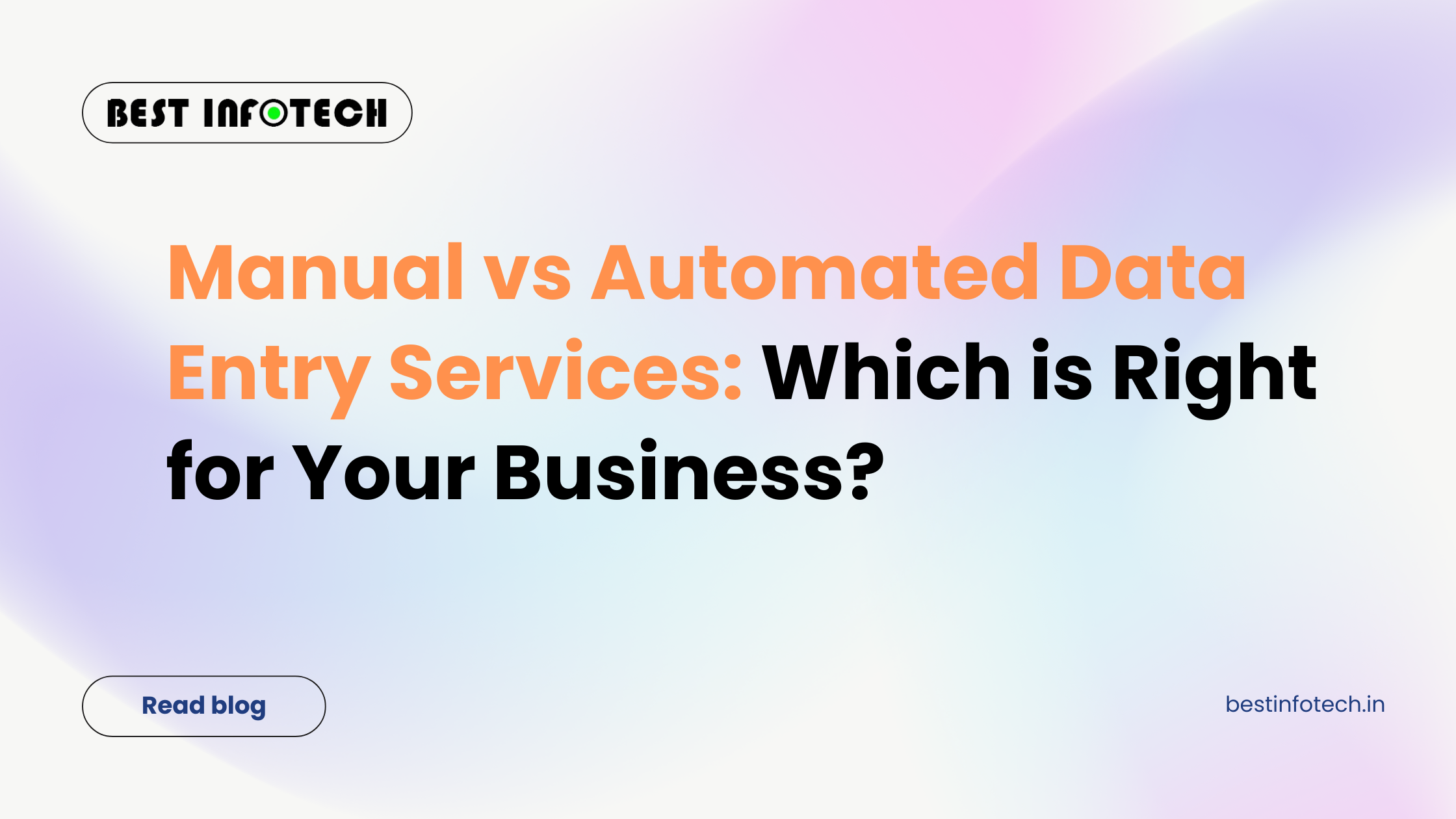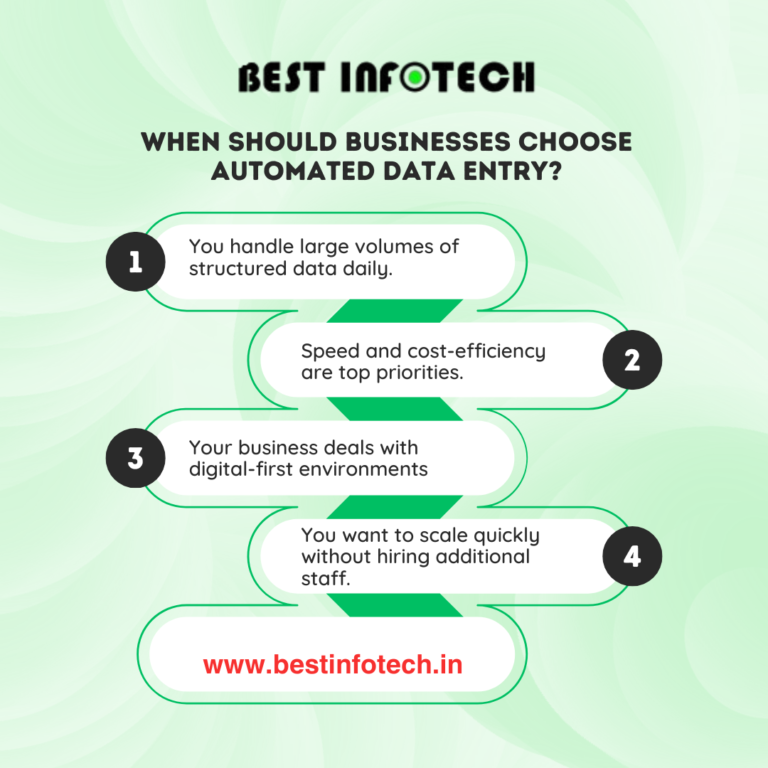Manual vs Automated Data Entry Services: Which is Right for Your Business?
 September 14, 2025
September 14, 2025 
In today’s data-driven world, businesses depend on accurate, timely, and organized data to make informed decisions. Data entry plays a crucial role in maintaining this accuracy. However, companies often face a choice: should they stick with manual data entry services or switch to automated data entry services?
Both approaches have their advantages and limitations, and the right choice depends on your business requirements, budget, and long-term goals. In this blog, we’ll compare manual vs automated data entry services to help you understand which option best suits your organization.
What is Manual Data Entry?
Manual data entry involves human operators inputting data from physical or digital sources into systems, spreadsheets, or databases. It’s a traditional method that relies on accuracy, speed, and attention to detail from trained professionals.
Key Features of Manual Data Entry:
Data entry clerks input information manually.
Human judgment helps identify errors or inconsistencies.
Suitable for unstructured data such as handwritten notes, survey responses, or scanned documents.
Advantages of Manual Data Entry:
Flexibility: Human operators can handle complex, irregular, or poorly structured data that automation might miss.
Accuracy with Context: Skilled professionals can interpret abbreviations, poor handwriting, or ambiguous entries.
Quality Control: Human review ensures data validity and consistency.
Limitations of Manual Data Entry:
Time-Consuming: Large volumes of data can take weeks or months to process.
Costly: Hiring and training staff increases operational expenses.
Human Errors: Fatigue and oversight can result in mistakes.
What is Automated Data Entry?
Automated data entry uses technology like Optical Character Recognition (OCR), Artificial Intelligence (AI), and Robotic Process Automation (RPA) to capture and process data without human intervention.
Key Features of Automated Data Entry:
Data is extracted automatically from scanned documents, images, or online forms.
AI-powered systems process large volumes of structured data rapidly.
Minimal manual intervention required for repetitive tasks.
Advantages of Automated Data Entry:
Speed: Processes thousands of records in minutes.
Cost-Efficient: Reduces manpower costs in the long term.
Consistency: Eliminates human errors and maintains uniformity.
Scalability: Easily adapts to large-scale operations.
Limitations of Automated Data Entry:
Setup Cost: Requires investment in software, tools, and IT infrastructure.
Limited Flexibility: Struggles with unstructured or handwritten data.
Technical Challenges: Systems may require frequent updates or troubleshooting.
Manual vs Automated Data Entry: A Direct Comparison
| Factor | Manual Data Entry | Automated Data Entry |
|---|---|---|
| Accuracy | High for complex/unstructured data (depends on operator skill) | High for structured data, consistent results |
| Speed | Slow, depends on manpower | Very fast, processes bulk data efficiently |
| Cost | High due to staff and overhead | Initial setup cost but cost-effective long term |
| Flexibility | Can handle ambiguous/unstructured data | Best for structured and repetitive tasks |
| Scalability | Limited by workforce capacity | Highly scalable with automation tools |
| Error Handling | Manual review helps detect unusual errors | Minimal human oversight; may miss context |
When Should Businesses Choose Manual Data Entry?
Manual data entry is a better option when:
Your data sources are unstructured or irregular, such as handwritten forms.
You need human judgment to interpret complex information.
Your organization deals with smaller volumes of data regularly.
Quality control and customized validation are critical.

When Should Businesses Choose Automated Data Entry?
Automated data entry works best when:
You handle large volumes of structured data daily.
Speed and cost-efficiency are top priorities.
Your business deals with digital-first environments (e.g., online forms, invoices).
You want to scale quickly without hiring additional staff.
The Hybrid Approach: Combining Manual and Automated Data Entry
In reality, many businesses benefit from a hybrid approach that combines manual and automated data entry services. For example, automation can process bulk structured data, while human operators handle exceptions, validation, and unstructured inputs.
This combination ensures both efficiency and accuracy, giving businesses the best of both worlds.
Which is Right for Your Business?
Choosing between manual vs automated data entry depends on your business model, data complexity, and growth plans. If your operations require precision with complex datasets, manual entry may be best. On the other hand, if you prioritize speed and scalability, automation offers significant advantages.
At Best Infotech Chennai, we specialize in providing both manual and automated data entry services tailored to your industry needs. Whether you’re in healthcare, finance, retail, or real estate, we design solutions that ensure accuracy, cost savings, and business efficiency.
Conclusion
Both manual and automated data entry services play vital roles in modern business operations. While manual entry provides flexibility and accuracy for complex data, automation ensures speed, scalability, and cost savings. For most businesses, the ideal solution is often a hybrid model that balances both.
Looking to streamline your data entry process with a reliable partner?
👉 Contact Best Infotech Chennai today to explore customized manual and automated data entry services that fit your business needs.
Contact us today